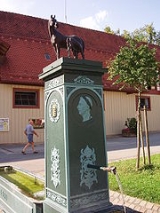
Marbach stud
Encyclopedia
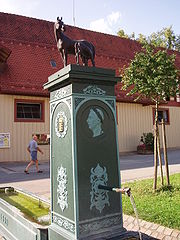
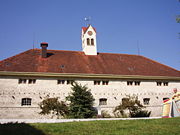
Stud farm
A stud farm or stud in animal husbandry, is an establishment for selective breeding of livestock. The word "stud" comes from the Old English stod meaning "herd of horses, place where horses are kept for breeding" Historically, documentation of the breedings that occur on a stud farm leads to the...
for horse breeding
Horse breeding
Horse breeding is reproduction in horses, and particularly the human-directed process of selective breeding of animals, particularly purebred horses of a given breed. Planned matings can be used to produce specifically desired characteristics in domesticated horses...
, has a history that dates back over 500 years. It is located in southwest Germany near Gomadingen
Gomadingen
Gomadingen is a town in the district of Reutlingen in Baden-Württemberg in Germany....
in the Reutlingen
Reutlingen
Reutlingen is a city in Baden-Württemberg, Germany. It is the capital of the eponymous district of Reutlingen. As of April 2008, it has a population of 109,828....
district of Baden-Württemberg
Baden-Württemberg
Baden-Württemberg is one of the 16 states of Germany. Baden-Württemberg is in the southwestern part of the country to the east of the Upper Rhine, and is the third largest in both area and population of Germany's sixteen states, with an area of and 10.7 million inhabitants...
. The annual stallion parade is an internationally known attraction, and the stud hosts over 500,000 visitors per year. The stud also offers courses for those wishing to learn to ride or drive, as well as an instructor training program. Marbach is known for producing athletic horses with good temperaments, and has careful management practices, including that of allowing young, untrained horses the opportunity to grow in a natural setting conducive to their mental as well as their physical development.
Marbach was originally significant for its development of the ancestral bloodstock of several warmblood
Warmblood
Warmbloods are a group of middle-weight horse types and breeds, primarily originating in Europe, registered with organizations that are characterized by open studbook policy, studbook selection, and the aim of breeding for equestrian sport...
horse breeds, and today continues to produce the Württemberger
Württemberger
The Württemberger, Baden-Württemberger or Württemberg is a Warmblood horse breed originating in Germany. They are primarily riding horses, and are selectively bred for dressage and show jumping.-Breed History:...
. However, it is probably best known as the home stud of the Weil-Marbach Arabians
Arabian horse
The Arabian or Arab horse is a breed of horse that originated on the Arabian Peninsula. With a distinctive head shape and high tail carriage, the Arabian is one of the most easily recognizable horse breeds in the world. It is also one of the oldest breeds, with archaeological evidence of horses...
. The majority of Arabian horses bred at Marbach are sold to private owners as personal riding horses, though some are also used in the sport of endurance riding
Endurance riding
Endurance riding is an equestrian sport based on controlled long-distance races. It is one of the international competitions recognized by the FEI. There are endurance rides worldwide....
. In addition to breeding Arabian and Württembergers, Marbach also stands stallions of the Black Forest cold blood
Black Forest Horse
The Black Forest Horse, also called the Black Forest cold blood or Schwarzwälder Kaltblut, is a rare draft horse breed originating in southern Germany.- Characteristics :...
breed as well as a few Thoroughbred
Thoroughbred
The Thoroughbred is a horse breed best known for its use in horse racing. Although the word thoroughbred is sometimes used to refer to any breed of purebred horse, it technically refers only to the Thoroughbred breed...
s, Haflinger
Haflinger (horse)
The Haflinger, also known as the Avelignese, is a breed of horse developed in Austria and northern Italy during the late 19th century. Haflinger horses are relatively small, are always chestnut in color, have distinctive gaits described as energetic but smooth, and are well-muscled yet elegant...
s and other heavy wamblood stallions. Horses bred at Marbach are performance tested before being allowed reproduce and are branded
Livestock branding
Livestock branding is a technique for marking livestock so as to identify the owner. Originally, livestock branding only referred to a hot brand for large stock, though the term is now also used to refer to other alternative techniques such as freeze branding...
with a brand
Branding iron
A branding iron is a tool which uses the process of pressing a heated metal shape against an object or livestock with the intention of leaving a mark....
symbol called the Hirschgeweih.
History
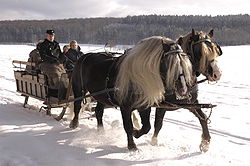
Christoph, Duke of Württemberg
Christoph of Württemberg, Duke of Württemberg ruled as Duke of Württemberg from 1550 until his death in 1568....
(r. 1550-1568) expanded the stud and in 1573 it was named a court and state stud, after the ruling Dukes realized a need for improvement in local horse breeds. During the 18th and 19th centuries, Marbach used Mecklenburger, Holstein
Holstein (horse)
The Holsteiner is a breed of horse originating in the Schleswig-Holstein region of northern Germany. It is thought to be the oldest of warmblood breeds, tracing back to the 13th century...
, and English and Norman-bred horses to improve quality in local horses, while heavier breeds such as the Cleveland Bay
Cleveland Bay
The Cleveland Bay is a breed of horse that originated in England during the 17th century, named after its colouring and the Cleveland district of Yorkshire. It is a well-muscled horse, with legs that are strong but short in relation to the body. The horses are always bay in colour, although a...
, Yorkshire Coach Horse
Yorkshire Coach Horse
The Yorkshire Coach Horse is an extinct horse breed once native to England. It was a large, strong, bay or brown horse with dark legs, mane and tail...
and Clydesdale
Clydesdale
Clydesdale was formerly one of nineteen local government districts in the Strathclyde region of Scotland.The district was formed by the Local Government Act 1973 from part of the former county of Lanarkshire: namely the burghs of Biggar and Lanark and the First, Second and Third Districts...
were used to make a larger, more solid horse. Following World War II and the recognition that there was less need for work horses
Draft horse
A draft horse , draught horse or dray horse , less often called a work horse or heavy horse, is a large horse bred for hard, heavy tasks such as ploughing and farm labour...
and a greater future in developing sport horse
Sport horse
Sport horse, or Sporthorse, is a term used to describe a type of horse, rather than any particular breed. The term generally refers to horses bred for the traditional Olympic equestrian sporting events of dressage, eventing, show jumping, and combined driving. The precise definition varies...
s and general light riding animals, the stud added additional lines such as the Thoroughbred
Thoroughbred
The Thoroughbred is a horse breed best known for its use in horse racing. Although the word thoroughbred is sometimes used to refer to any breed of purebred horse, it technically refers only to the Thoroughbred breed...
and Trakehner
Trakehner
Trakehner is a light warmblood breed of horse, originally developed at the East Prussian state stud farm in the town of Trakehnen from which the breed takes its name...
, with the Marbach stallion Julmond (1938–1965) a significant contributor of traits that transformed the Württemberger
Württemberger
The Württemberger, Baden-Württemberger or Württemberg is a Warmblood horse breed originating in Germany. They are primarily riding horses, and are selectively bred for dressage and show jumping.-Breed History:...
from a work horse
Working animal
A working animal is an animal, usually domesticated, that is kept by humans and trained to perform tasks. They may be close members of the family, such as guide or service dogs, or they may be animals trained strictly to perform a job, such as logging elephants. They may also be used for milk, a...
into a sport horse
Sport horse
Sport horse, or Sporthorse, is a term used to describe a type of horse, rather than any particular breed. The term generally refers to horses bred for the traditional Olympic equestrian sporting events of dressage, eventing, show jumping, and combined driving. The precise definition varies...
.
Weil
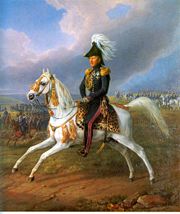
Württemberg
Württemberg , formerly known as Wirtemberg or Wurtemberg, is an area and a former state in southwestern Germany, including parts of the regions Swabia and Franconia....
for the purpose of breeding Arabian horse
Arabian horse
The Arabian or Arab horse is a breed of horse that originated on the Arabian Peninsula. With a distinctive head shape and high tail carriage, the Arabian is one of the most easily recognizable horse breeds in the world. It is also one of the oldest breeds, with archaeological evidence of horses...
s. Among the foundation horses was the mare
Mare (horse)
A mare is an adult female horse or other equine.In most cases, a mare is a female horse over the age of three, and a filly is a female horse age three and younger. However, in Thoroughbred horse racing, a mare is defined as a female horse more than four years old; in harness racing a mare is a...
Murana I 1808, whose dam line still continues at Marbach today. The stallions
Stallion (horse)
A stallion is a male horse that has not been gelded .Stallions will follow the conformation and phenotype of their breed, but within that standard, the presence of hormones such as testosterone may give stallions a thicker, "cresty" neck, as well as a somewhat more muscular physique as compared to...
Bairactar, imported directly from the Arabian desert
Arabian Peninsula
The Arabian Peninsula is a land mass situated north-east of Africa. Also known as Arabia or the Arabian subcontinent, it is the world's largest peninsula and covers 3,237,500 km2...
and his son Amurath I 1829 played a significant part in the development of the Arabian breed at Weil, and made major contributions to the breed throughout Europe, particularly on Arabian horses bred in Poland.
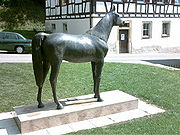
Weil-Marbach transition
While this establishment thrived though the 19th century, from 1890 on, it went into considerable decline and by the time the Weil herd was transferred from Princess Pauline zu Wied of Württemberg to the Marbach State Stud in 1932, only 17 purebred Arabians remained. To expand the breeding pool, Arabian horses from Poland were used, particularly those of the Ofir line such as the Witez IIWitez II
Witez II was a bay Arabian stallion foaled at the Janów Podlaski stud in Poland. Foaled April 1, 1938, he spent his early years at Janów at a time when Poland was under occupation by Nazi Germany before ultimately arriving in the United States in 1945, where he lived for the remainder of his life...
son Wisznu and the stallion Abu Afas. In 1955, the Arabian stallion
Stallion
A Stallion is a male horse.Stallion may also refer to:* Stallion , an American pop rock group* Stallion , a figure in the Gobot toyline* Stallion , a character in the console role-playing game series...
Hadban Enzahi
Hadban Enzahi
Hadban Enzahi, Foaled 15 August 1952 in El Zahraa, Egypt, and dying of heatstroke on 22 July 1975, was a gray Arabian stallion imported from Egypt, who stood at the Marbach stud in Germany...
was imported from Egypt
Egypt
Egypt , officially the Arab Republic of Egypt, Arabic: , is a country mainly in North Africa, with the Sinai Peninsula forming a land bridge in Southwest Asia. Egypt is thus a transcontinental country, and a major power in Africa, the Mediterranean Basin, the Middle East and the Muslim world...
, along with some other breeding stock, and this infusion of new blood added to the foundation animals established the Weil-Marbach line of Arabians. Since the importation of Hadban Enzahi, the focus of Marbach shifted to Arabian breeding of strongly Egyptian bloodlines, though the older lines are also preserved.

